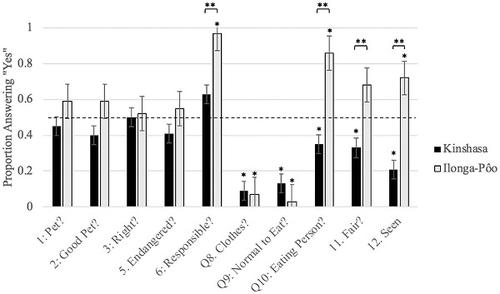当前位置:
X-MOL 学术
›
Am. J. Primatol.
›
论文详情
Our official English website, www.x-mol.net, welcomes your feedback! (Note: you will need to create a separate account there.)
Assessing conservation attitudes and behaviors of Congolese children neighboring the world's first bonobo (Pan paniscus) release site
American Journal of Primatology ( IF 2.4 ) Pub Date : 2020-11-23 , DOI: 10.1002/ajp.23217 Aleah Bowie 1 , Kara Walker 2 , Gabrielle Bunnell 1 , Dominique Morel 3 , Fanny Minesi 3 , Raphael Belais 3 , Brian Hare 1, 4
American Journal of Primatology ( IF 2.4 ) Pub Date : 2020-11-23 , DOI: 10.1002/ajp.23217 Aleah Bowie 1 , Kara Walker 2 , Gabrielle Bunnell 1 , Dominique Morel 3 , Fanny Minesi 3 , Raphael Belais 3 , Brian Hare 1, 4
Affiliation

|
Poaching and habitat destruction in the Congo Basin threaten African great apes including the bonobo (Pan paniscus), chimpanzees (Pan troglodytes), and gorillas (Gorilla spp.) with extinction. One way to combat extinction is to reintroduce rescued and rehabilitated apes and repopulate native habitats. Reintroduction programs are only successful if they are supported by local populations. Ekolo ya Bonobo, located in Equateur province of the Democratic Republic of Congo (DRC), is the world's only reintroduction site for rehabilitated bonobos. Here we assess whether children, of the Ilonga‐Pôo, living adjacent to Ekolo ya Bonobo demonstrate more pro‐ape conservation attitudes than children living in, Kinshasa, the capital city. We examined children's attitudes toward great apes because children are typically the focus of conservation education programs. We used the Great Ape Attitude Questionnaire to test the Contact Hypothesis, which posits that proximity to great ape habitat influences pro‐conservation attitudes toward great apes. Ilonga‐Pôo children who live in closer contact with wild bonobos felt greater responsibility to protect great apes compared to those in Kinshasa who live outside the natural habitat of great apes. These results suggest that among participants in the DRC, spatial proximity to a species fosters a greater sense of responsibility to protect and conserve. These results have implications for the successful implementation of great ape reintroduction programs in the Congo Basin. The data analyzed in this study were collected in 2010 and therefore provide a baseline for longitudinal study of this reintroduction site.
中文翻译:

评估世界上第一个bo黑猩猩(Pan paniscus)释放地点附近的刚果儿童的保护态度和行为
刚果盆地的偷猎和栖息地破坏威胁着非洲大猿猴,包括the黑猩猩(Pan paniscus),黑猩猩(Pan troglodytes)和大猩猩(Gorilla spp。)灭绝。。应对灭绝的一种方法是重新引入经过拯救和恢复原状的猿猴,并重新居住在原生栖息地中。只有在当地居民的支持下,重新引进计划才能成功。Ekolo ya Bonobo位于刚果民主共和国(DRC)的赤道省,是世界上唯一的修复黑no虫的重新引进地点。在这里,我们评估居住在伊隆加-普奥(Elonga-Pôo)的儿童是否比居住在首都金沙萨的儿童表现出更多的亲亲保护态度。我们研究了儿童对大猩猩的态度,因为儿童通常是保护教育计划的重点。我们使用了《大猿人态度调查表》来检验接触假说,这表明接近大猿类栖息地会影响人们对大猿类的保护态度。与居住在大猿类自然栖息地之外的金沙萨儿童相比,与野生bo黑猩猩紧密接触的伊隆加普奥儿童对保护大猿类负有更大的责任。这些结果表明,在刚果(金)的参与者中,与物种的空间近距离可增强其保护和养护的责任感。这些结果对在刚果盆地成功实施大猿类引进计划具有重要意义。这项研究中分析的数据是在2010年收集的,因此为该重新引入地点的纵向研究提供了基线。与居住在大猿类自然栖息地之外的金沙萨儿童相比,与野生bo黑猩猩紧密接触的伊隆加普奥儿童对保护大猿类负有更大的责任。这些结果表明,在刚果(金)的参与者中,与物种的空间近距离可增强其保护和养护的责任感。这些结果对在刚果盆地成功实施大猿类引进计划具有重要意义。这项研究中分析的数据是在2010年收集的,因此为该重新引入地点的纵向研究提供了基线。与居住在大猿类自然栖息地之外的金沙萨儿童相比,与野生bo黑猩猩紧密接触的伊隆加普奥儿童对保护大猿类负有更大的责任。这些结果表明,在刚果(金)的参与者中,与物种的空间近距离可增强其保护和养护的责任感。这些结果对在刚果盆地成功实施大猿类引进计划具有重要意义。这项研究中分析的数据是在2010年收集的,因此为该重新引入地点的纵向研究提供了基线。这些结果对在刚果盆地成功实施大猿类引进计划具有重要意义。这项研究中分析的数据是在2010年收集的,因此为该重新引入地点的纵向研究提供了基线。这些结果对在刚果盆地成功实施大型猿猴再引进计划具有影响。这项研究中分析的数据是在2010年收集的,因此为该重新引入地点的纵向研究提供了基线。
更新日期:2021-01-04
中文翻译:

评估世界上第一个bo黑猩猩(Pan paniscus)释放地点附近的刚果儿童的保护态度和行为
刚果盆地的偷猎和栖息地破坏威胁着非洲大猿猴,包括the黑猩猩(Pan paniscus),黑猩猩(Pan troglodytes)和大猩猩(Gorilla spp。)灭绝。。应对灭绝的一种方法是重新引入经过拯救和恢复原状的猿猴,并重新居住在原生栖息地中。只有在当地居民的支持下,重新引进计划才能成功。Ekolo ya Bonobo位于刚果民主共和国(DRC)的赤道省,是世界上唯一的修复黑no虫的重新引进地点。在这里,我们评估居住在伊隆加-普奥(Elonga-Pôo)的儿童是否比居住在首都金沙萨的儿童表现出更多的亲亲保护态度。我们研究了儿童对大猩猩的态度,因为儿童通常是保护教育计划的重点。我们使用了《大猿人态度调查表》来检验接触假说,这表明接近大猿类栖息地会影响人们对大猿类的保护态度。与居住在大猿类自然栖息地之外的金沙萨儿童相比,与野生bo黑猩猩紧密接触的伊隆加普奥儿童对保护大猿类负有更大的责任。这些结果表明,在刚果(金)的参与者中,与物种的空间近距离可增强其保护和养护的责任感。这些结果对在刚果盆地成功实施大猿类引进计划具有重要意义。这项研究中分析的数据是在2010年收集的,因此为该重新引入地点的纵向研究提供了基线。与居住在大猿类自然栖息地之外的金沙萨儿童相比,与野生bo黑猩猩紧密接触的伊隆加普奥儿童对保护大猿类负有更大的责任。这些结果表明,在刚果(金)的参与者中,与物种的空间近距离可增强其保护和养护的责任感。这些结果对在刚果盆地成功实施大猿类引进计划具有重要意义。这项研究中分析的数据是在2010年收集的,因此为该重新引入地点的纵向研究提供了基线。与居住在大猿类自然栖息地之外的金沙萨儿童相比,与野生bo黑猩猩紧密接触的伊隆加普奥儿童对保护大猿类负有更大的责任。这些结果表明,在刚果(金)的参与者中,与物种的空间近距离可增强其保护和养护的责任感。这些结果对在刚果盆地成功实施大猿类引进计划具有重要意义。这项研究中分析的数据是在2010年收集的,因此为该重新引入地点的纵向研究提供了基线。这些结果对在刚果盆地成功实施大猿类引进计划具有重要意义。这项研究中分析的数据是在2010年收集的,因此为该重新引入地点的纵向研究提供了基线。这些结果对在刚果盆地成功实施大型猿猴再引进计划具有影响。这项研究中分析的数据是在2010年收集的,因此为该重新引入地点的纵向研究提供了基线。



























 京公网安备 11010802027423号
京公网安备 11010802027423号